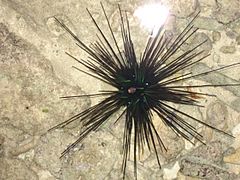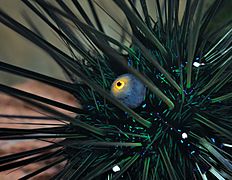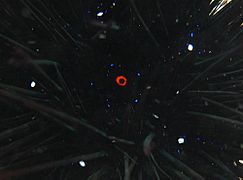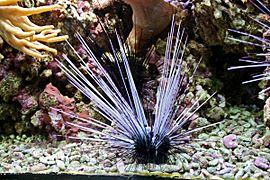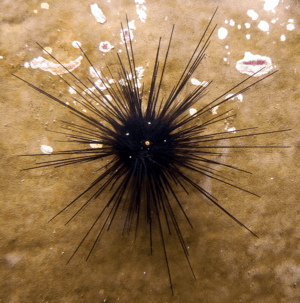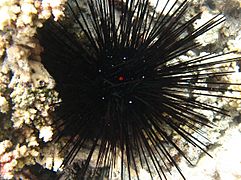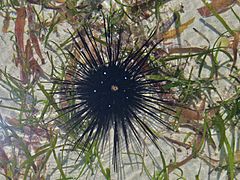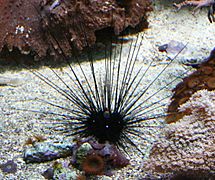Diadema setosum facts for kids
Quick facts for kids Black long spine urchin |
|
|---|---|
 |
|
| Diadema setosum in Oman. | |
| Scientific classification | |
| Kingdom: | |
| Phylum: | |
| Class: | |
| Order: |
Diadematoida
|
| Family: |
Diadematidae
|
| Genus: |
Diadema
|
| Species: |
D. setosum
|
| Binomial name | |
| Diadema setosum Leske, 1778
|
|
| Synonyms | |
|
|
The Diadema setosum is a type of sea urchin with very long spines. It belongs to a family called Diadematidae. This sea urchin has super long, hollow spines. These spines have a mild venom in them.
You can tell D. setosum apart from other similar sea urchins. It has five special white dots on its body. These sea urchins live in the Indo-Pacific area. This includes places from Australia and Africa all the way to Japan and the Red Sea. Even though their stings can hurt if you step on them, they are not very dangerous to people.
What it Looks Like
The Diadema setosum is a typical sea urchin. Its body is round and black, like a ball. This round part is called the test. All of its inside parts are safe inside this test. The body is not perfectly round; it's a little bit flat on the top and bottom.
Long spines stick out from its body. These spines are what make sea urchins famous! Like other sea urchins in its family, D. setosum has very long and thin spines. The spines are usually black, but sometimes they have brown stripes. They are hollow and contain a mild venom. You can spot D. setosum because it has five white spots on its test. These spots are placed between the urchin's special grooves.
Another clear sign of this sea urchin is a bright orange ring. This ring is found around a part of its body called the periproctal cone. Some other small details include blue spots on its genital plates. It also has blue spots (called iridophores) in lines along its body.
Adult Diadema setosum usually weigh between 35 and 80 grams. Their body (test) is about 70 millimeters wide. They are around 40 millimeters tall.
Where it Lives
The Diadema setosum sea urchin lives in many places. Its natural home is all across the Indo-Pacific ocean. This stretches from the Red Sea in the west to the coast of Australia in the east. From north to south, you can find it as far north as Japan. It also lives as far south as the bottom tip of Africa's east coast.
This sea urchin has also moved to new places. In 2006, two live Diadema setosum were found in Turkey. This made D. setosum the first sea urchin from the Red Sea to invade the Mediterranean Sea. Scientists think a few things might have caused this. The baby urchins (larvae) might have traveled through the Suez Canal. This canal connects the Red Sea to the Mediterranean. Another idea is that ships carried them in their ballast water. It's also possible that people who keep aquariums let them go on purpose.
Diadema setosum often lives near coral reefs. But you can also find them on sandy areas and in seagrass beds. These sea urchins are big eaters of algae. They help keep coral reefs healthy by eating different types of algae.
In Hong Kong, you can find many Diadema setosum on rocky reefs. There can be one urchin for every 3.4 square meters. Scientists believe there are so many because it's partly natural. Also, people have caught too many of its main predator, the blackspot tuskfish.
Life and Habits
Diadema setosum can lay eggs (spawn) at different times. Some groups spawn only during certain seasons. Others spawn all year long. It seems that water temperature plays a role in when they spawn. Temperatures above 25 degrees Celsius (77 degrees Fahrenheit) might make them start spawning.
Sea urchins living near the equator often spawn throughout the whole year. This happens with D. setosum in the Philippines. In the Persian Gulf, they spawn in April and May. The moon's phases can also affect spawning. These sea urchins have been seen to spawn when there is a full moon.
Scientists believe Diadema setosum is one of the oldest types of sea urchins in its group. Studies of their genes show that D. setosum is like an ancient relative. It's the "sister group" to all other members of its genus. Looking at their body shapes also supports this idea. This means D. setosum might be the oldest living species in the Diadema group.
Like other sea urchins with venom, the venom of Diadema setosum is mild. It is not deadly to humans. The toxin mostly causes swelling and pain. The pain usually goes away after a few hours. The real danger comes from the spines themselves. They are very thin and break easily inside your skin. It can be hard to get them out.
When it comes to behavior, D. setosum can avoid danger. If something hits them or breaks a spine, they can quickly flip over. Then they "run" on the tips of their longest spines. If they hit small things, they will roll like a robot. They have been seen moving 30 inches in just 7 seconds this way!
These sea urchins also have very good vision for a sea urchin. They can move their spines towards fish that swim by. This helps them defend themselves. Scientists think they might see by sensing light that goes into each spine. This light then travels down the spine to its base, where it is sensed. More research is needed to fully understand this.
Gallery
-
From Zanzibar
-
From la Réunion
-
A specimen encountered in Kenya. The 5-fold symmetry is obvious.
See also
 In Spanish: Erizo diadema para niños
In Spanish: Erizo diadema para niños


